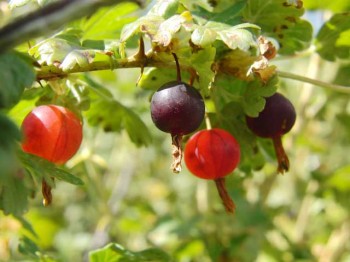
The currants and gooseberries are ripe now, and oh what a currant season the current season is!
I had an inkling of the potential the other day when we visited the Como Roundhouse during Railroad Days and Deb was kind enough to let Gregg and I and Kor from Holland out back to see the ruins of the housing tenements, where I found big bushes laden with ripe and hairy but not altogether tasty red currants. Yesterday, however, when we pulled into the parking lot of the Limber Grove Trail, berries were the first thing I saw.
I couldn’t believe the size of those purple berries. There were so many of them—and the biggest I’ve ever seen! So eager was I to begin collecting that I didn’t realize I’d positioned myself in a big anthill until ants were swarming up my leg. After hopping around maniacally to shake them off, however, I found better footing and returned to my collecting.
The bushes were rife with big, painful spines, complicating picking. When I absentmindedly tried raking the bush with my fingers like I do with huckleberries, I wound up cutting a painful, horizontal paper-cut-like slice into a purple-red stained finger.
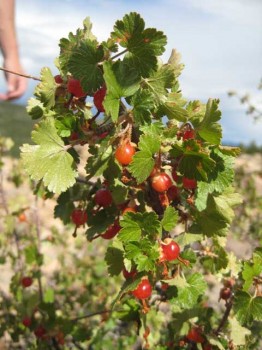
Gooseberry or Currant? You Tell Me.
In Wild Berries of the West (2001), Betty B. Derig and Margaret C. Fuller lay out many Ribes species (which are in the gooseberry family, Grossulariaceae) in detail with entries on six different kinds of gooseberries and five different kinds of currants. “The Ribes genus includes gooseberries and currants,” they explain. “Gooseberries supposedly have spines and currants do not, but common names being inconsistent, a few ‘gooseberries’ lack spines and a few ‘currants’ have them.” Of swamp gooseberries (Ribes lacustre), they say to “avoid the spines as they can produce an allergic reaction.”
What is consistent, however, is that “all Ribes species have lobed, maplelike leaves but often with rounded points.” In my experience, these leaves range from very tiny to half the size of my hand in a low-lying spineless Ribes variety that has fat, juicy black berries. Earlier in the season, Ribes flowers present as dangling tubes or cups, as Derig and Fuller describe them. The berries range in color from yellow-green to red to deep purple or black; some plants have spines and some do not; some berries are hairy or sticky and some are smooth. Most Ribes berries I’ve encountered have the dried remnants of the flowers attached, sticking off the ends of them in such as manner as to help with identification. I do not bother removing these when preparing the berries for consumption.
Derig and Fuller explain the term “gooseberry” as originating in the old English custom of stuffing a roast goose with the berries, whereas “the name ‘currant’ comes from Corinth, the home of a small purple grape (Uva corinthiaca) that is sold commercially as a currant.” What? Are the currants my dad has for years spoken so glowingly about not, in fact, currants?
Anyway, I’m not as concerned with differentiating my Ribesas I am with collecting and eating them. Call ‘em what you want; I use the word “currant” loosely herein.

This Place Needs an Ant Eater
The trick to finding the biggest purple berries, I discovered, was sticking my face underneath and looking up. The biggest berries seem to hide, dangling amidst the leaves, but once I’d spotted them there was no escape. At one point Gregg exclaimed that he’d found the biggest berry ever, extracting and proudly displaying it for me to fawn over. “Wow, that’s amazing,” I told him as sincerely as I could muster—but the honest truth is that my technique yielded numerous berries of the same size. I don’t want to hurt his feelings, though, so let’s just keep that to ourselves.
After depleting the first bush of all its biggest, juiciest berries, I headed to an even more fruitful bush sporting monstrous berries, scoped out the earth under my feet, and set about to collecting again. So deep was my concentration on berries, however, that I didn’t realize that what I’d thought was a packed-down wet hill devoid of ants was in fact a big ant hill too—nay, an entire ant civilization—which I discovered only after ants had reached my neck and head and hair. This time, Gregg helped me strip off my clothes while I cavorted about half-naked trying to get all those ants off.
Glancing back, I saw the ants scurrying every which way in an effort to cover up a nest of babies that I’d somehow managed to uncover. I thought about how wonderfully opportunistic it would be to just scoop up all those guys and eat them, maybe fried in a little oil.
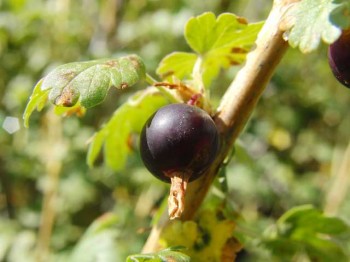
Dining on Insects in My Dreams
I’ve been brainstorming wild proteins of late, but as I have mentioned, Gregg is not amenable to eating squirrels or rabbits or any of our other “friends” around the house, and I am intrigued but not entirely motivated yet by the prospect of foraging roadkill—so I’m starting to think that bugs might be the ticket.
After all, the babies of Liometopum apiculatum ants, “escamoles” in Spanish, are highly sought after in some culinary circles—even smuggled into the United States from Mexico and other parts for adventurous American chefs, a fact I learned in Dana Goodyear’s August 15, 2011 New Yorker article, “Grub: Eating Bugs to Save the Planet.” I can’t afford to eat fancy bugs, however, so I’ll just have to go DIY and get them from under the woodpile or something.
The “Grub” article describes many different ways people have served many different insects, including grasshoppers, crickets, mealworms, waxworms, ant eggs, scorpions, tarantulas and more, although it does not include ‘how-to’ information. Just imagine, however—if I could get this whole bug thing worked out, I might come to think of stepping in a giant anthill as a boon rather than a curse. All those plump and crunchy ants, those soft, squirming babies—Mmm!
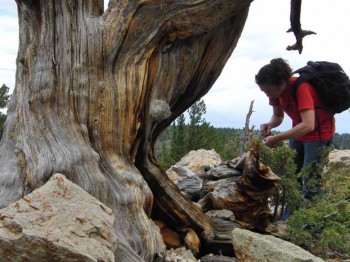
According to Goodyear, 80% of the world “eats insects with pleasure,” and apparently insect-eating, like foraging for food in the wild or at least eating wild-foraged food, is coming back into fashion in the United States’ novelty food market (Remember chocolate-covered ants?) “The current vogue reflects not only the American obsession with novelty and the upper-middle-class hunger for authenticity but also deep anxiety about the meat we already eat—which is its own kind of fashion,” writes Goodyear, while putting forth entomophagy, the study of insect-eating, as an ethical and logical response to projected food shortages. Furthermore, because insects are cold-blooded they are “about four times as efficient at converting feed to meat as are cattle …ounce for ounce, many have the same amount of protein as beef.”
I remained with practical questions after reading the article, such as: 1) What bugs can I eat? 2) How do I harvest them so I don’t end up with ants all over my body again? 3) How to I prepare them? and 4) If I uncover a nest like I did yesterday, can I sustainably harvest and then eat some of those ants and their larvae? But then I found this shining light, also referenced in Goodyear—Girl Meets Bug, a blog about “Edible Insects: the Eco-Logical Alternative” that seems to be a good starting point for answering some of these questions and contains recipes for many different kinds of bugs. OMG, can I just say—I can’t wait to eat bugs! I love them already.
The other thing I love is the internet, for I am old enough to remember life before it, and only for its existence can I take comfort in the fact that there are like-minded people out there. This after spending so many years cut off, sequestered in the microcosm of my longtime reality as always, incurably and unquestionably, the weirdest one in the bunch.
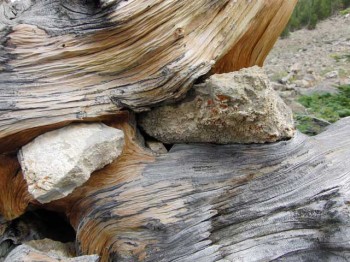
Berries and 1,500 Year Old Trees
1,500 year-old-trees do not remember the internet—nor television, phones, or horse-drawn buggies for that matter. If you’ll permit a bit of anthropomorphism, those ancient trees probably do remember our native forbears, however. Perhaps it is the women they remember, once upon a time foraging for berries in their midst.
We walked that path through history yesterday as we visited the 1,000-1,500 year-old limber pines (and some bristlecones, according to the sign), Gregg admiring the ancient beauties as I foraged both purple and red Ribes berries from the robust bushes amongst them, connecting to my own long lost past in the process.
The limber pines are big, gnarled beauties—old wood with which Gregg is eternally enthralled. He took many pictures of what he calls “root rocks” (not to be confused with the genre of music, “roots rock”) where the trees’ ancient roots have partially encapsulated and lifted up rocks in varying artistic configurations. “I took the best root rocks pictures of my life,” he said on our way back.
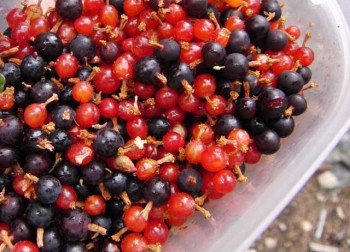
I found it interesting how the two types of Ribes bushes—one spineless, bearing juicy, red, piney-smelling mild berries and the other sharp with spines bearing big, puckery purple Ribes like the ones we found near the car—seem to grow in concert with one another, alternating red then purple and so forth. I gathered a couple cups of combined colors into a container made of plastic, very much unlike the prehistoric peoples who preceded me. The bushes, like the limber pines, were growing straight out of the rocky talus, not another plant in sight. Nature is so varied in its beauty.
The End

I imagine we’ve both eaten a fair amount of bugs this year, considering how many wild mushrooms we’ve tried. However, I find roadkill to be a much more reliable and fast way to ingest protein.
Any current currant jam recipe links you recommend? We currently have currants in our bush here in BC Canada. 🙂
Thanks for sharing.
Hi Free Range Mama! Hi Butter! Gosh sorry I’ve been out of touch for a week. I do not currently have a currant jam recipe. In fact, I’m ashamed to admit those currants are currently still sitting in my refrigerator. I just hit two deadlines, though, thankfully, so now it is time to deal with them–and my plan is just to cook them down, possibly strain out the skins and dried flowers, sweeten, and follow the instructions on the pectin box to jellify. I’ll try to let you know how it goes! Meantime if you find something better or have some other recipe idea, I’m totally all ears.
These berries look delicious! I thought they were gooseberries in your first picture, but I didnt realize how closely related gooseberries and currants are… Thanks for the fascinating and informative post!
@Berlin: Thanks for the kind words! After reading your comment, though, I decided to use the term “currant” less generally, replacing several instances of it with “Ribes” in order to be consistent with what seems to be the more common usage of “gooseberry” to refer to the purple spiny Ribes. Cheers:)
I hiked Pineridge Natural Area in Fort Collins today looking for a specimen of Rubus deliciosus and failed but found little red sweet wild gooseberries instead!!